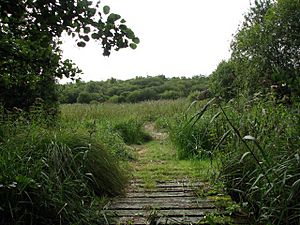Bure Marshes National Nature Reserve facts for kids
The Bure Marshes National Nature Reserve (NNR) is a special wild area in Norfolk, England. It is part of The Broads National Park, which is a unique network of rivers and lakes. This reserve is looked after by Natural England, an organization that helps protect nature in England.
Contents
What is the Bure Marshes Reserve?
The Bure Marshes NNR is mostly a type of wetland called a fen. Fens are like marshes but get their water from groundwater, not just rain. This makes them very rich in nutrients. The reserve also includes four large lakes, known as "Broads." These Broads were not always lakes. They were created a long time ago, between the years 900 and 1350. People dug out peat, which is like a very old, compressed plant material, to use as fuel. Over time, these peat pits filled with water, forming the Broads we see today.
The Four Special Broads
Within the Bure Marshes National Nature Reserve, you will find four important Broads:
- Hoveton Great Broad: This Broad is managed by Natural England. It is a great place to see many kinds of wildlife.
- Decoy Broad: Also managed by Natural England, Decoy Broad is another key part of the reserve.
- Ranworth Broad: This Broad is owned and managed by the Norfolk Wildlife Trust. They work hard to protect its natural beauty.
- Cockshoot Broad: Like Ranworth Broad, Cockshoot Broad is also cared for by the Norfolk Wildlife Trust.
These Broads and the surrounding fen lands are very important for nature. They provide homes for many different plants and animals.
Amazing Wildlife and Plants
The Bure Marshes NNR is a fantastic place for wildlife. It is an area of natural marshland that has not been changed much by people. This means it supports many rare and special species.
Rare Plants and Insects
You can find some very unusual plants here, like the crested buckler fern. This fern is quite rare in Britain. The reserve is also home to many rare moths and spiders. If you look closely, you might even spot some of Britain's rarest aquatic insects. These insects live in the water and are a sign of a very healthy environment.
Traditional Harvesting
In some parts of the open fens, people still harvest plants like reed, sedge, and marsh hay. This is a traditional practice that has gone on for hundreds of years. These plants are mainly used for the thatching industry. Thatching is a way of making roofs for buildings using dried plants, like reeds. It is a very old and skilled craft.
The Bure Marshes National Nature Reserve is a wonderful example of how we can protect important natural places. It helps us learn about unique habitats and the amazing creatures that live there.


